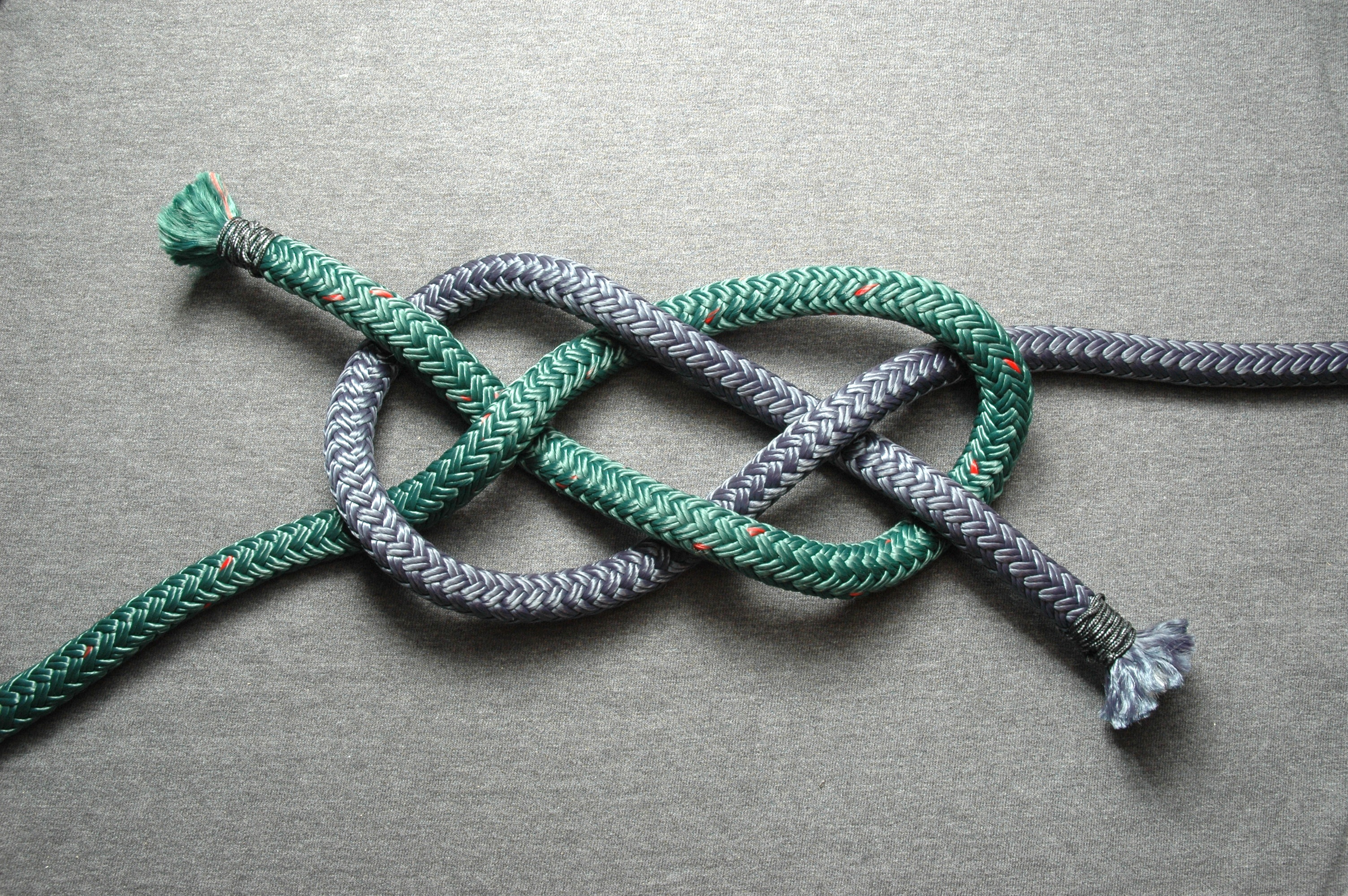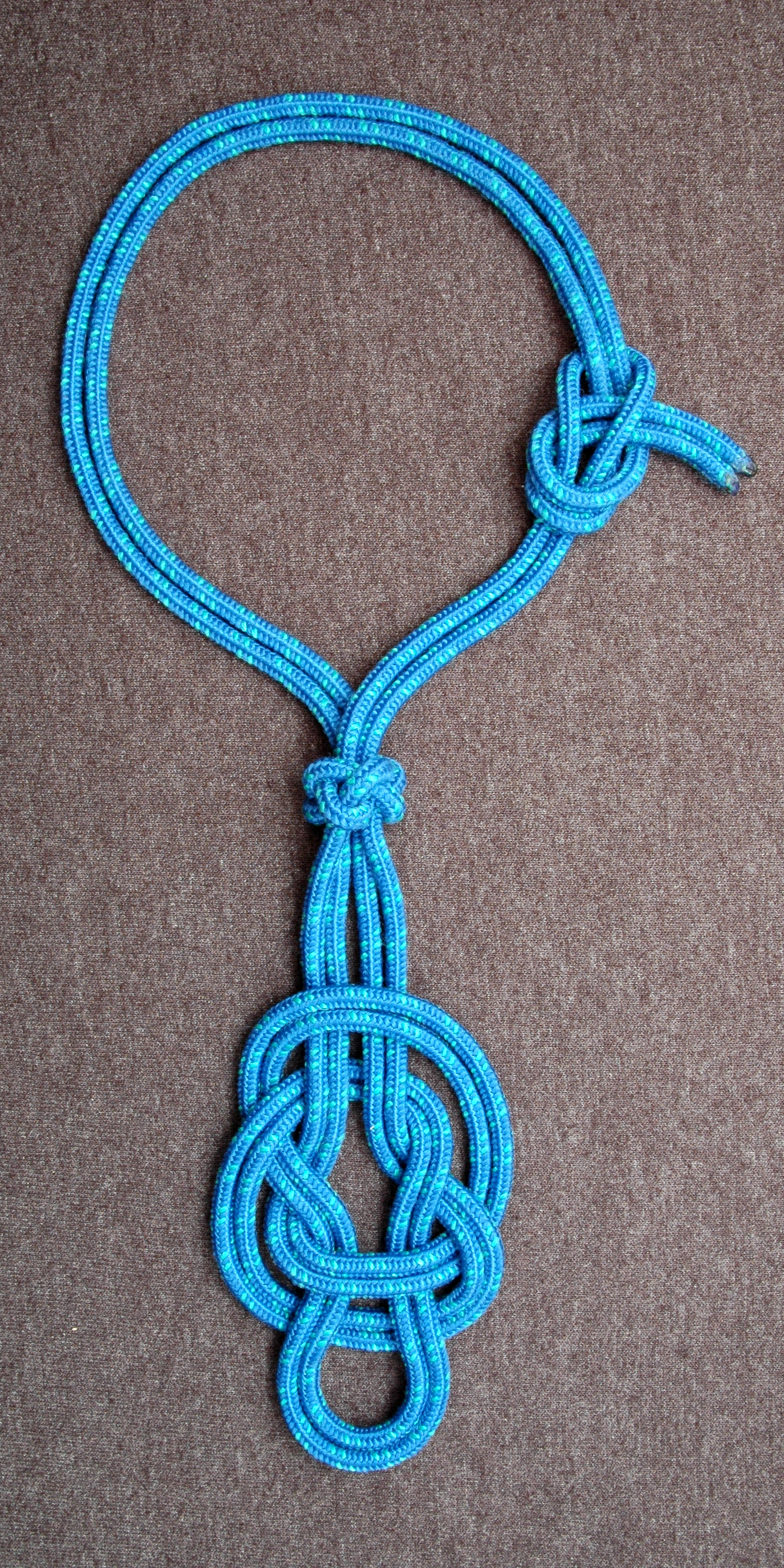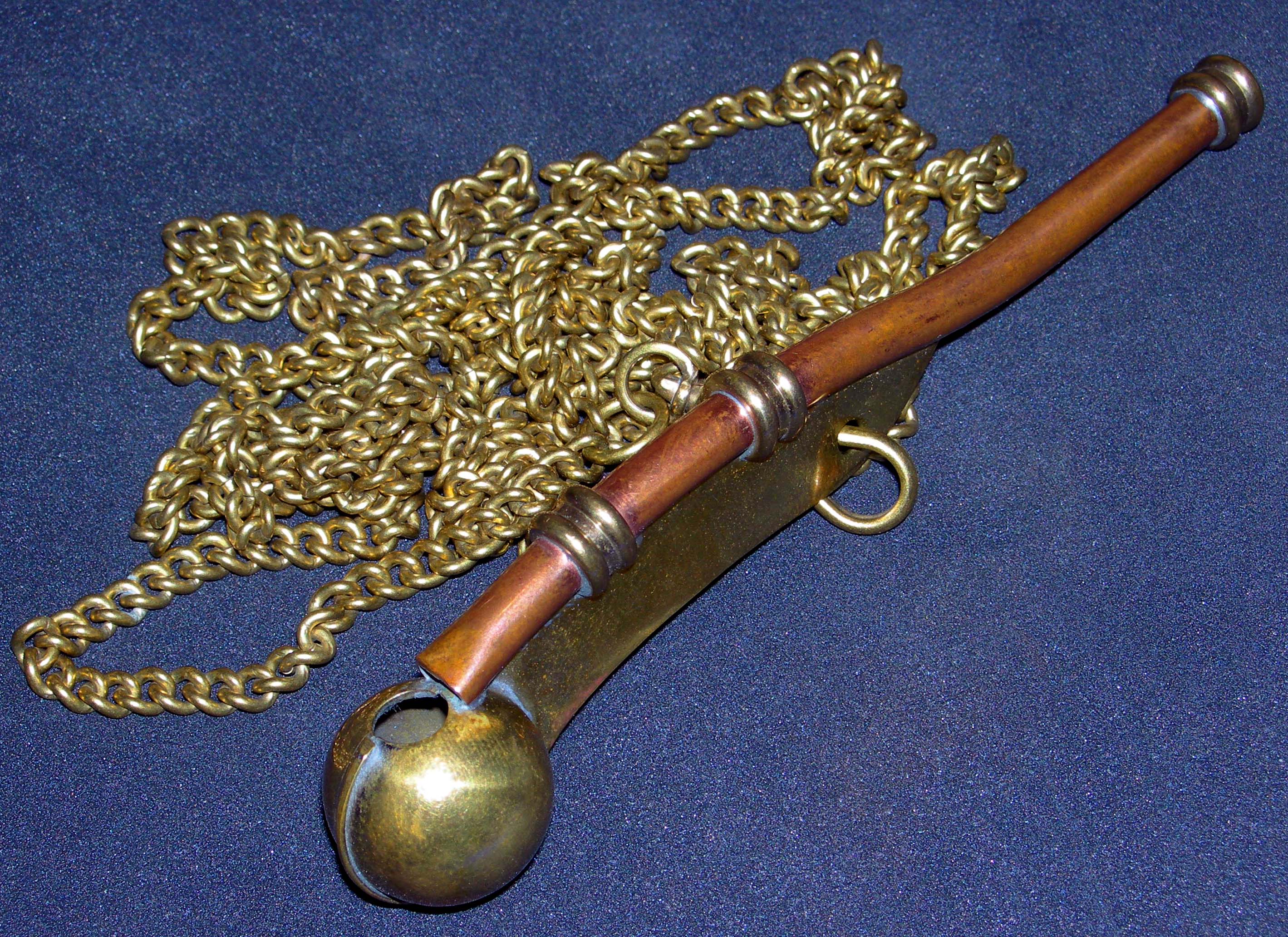|
Diamond Knot
The diamond knot (or knife lanyard knot) is a knot for forming a decorative loop on the end of a cord such as on a lanyard. A similar knot, also called the diamond knot, is a multistrand stopper knot, that is similar in appearance (although the footrope knot is really more similar, but it is simply an upside down diamond knot). To avoid confusion, it is advisable to call this knot the knife lanyard knot. This knot is a four strand diamond knot implemented in two strands. The knife lanyard knot is "tied alike" the Chinese button knot, "but they are worked differently."Ashley (1944), p.101. Tying The diamond knot begins as a Carrick bend with the ends exiting diagonally opposite each other. When the steps below are completed the knot is rearranged and tightened so that the ends emerge from the knot parallel and opposite their own standing part. A Chinese button knot is often tied in a very similar manner, but without leaving a loop at the end. Image:Knife-lanyard-knot-ABOK-7 ... [...More Info...] [...Related Items...] OR: [Wikipedia] [Google] [Baidu] |
Carrick Bend
The Carrick bend, also known as the Sailor's breastplate, is a knot used for joining two lines. It is particularly appropriate for very heavy rope or cable that is too large and stiff to be easily formed into other common bends.Geoffrey Budworth, ''The Complete Book of Knots'' (London: Octopus, 1997), 43.Brion Toss, ''Chapman's Nautical Guides: Knots'' (New York: Hearst Marine Books, 1990), 79–80. It will not jam even after carrying a significant load or being soaked with water.Clifford W. Ashley, ''The Ashley Book of Knots'' (New York: Doubleday, 1944), 262–263. As with many other members of the basket weave knot family, the carrick bend's aesthetically pleasing interwoven and symmetrical shape has also made it popular for decorative purposes. Heraldry The Carrick bend is known as the "Wake knot" or "Ormonde knot" when it is used as a heraldic badge.Arthur Charles Fox-Davies, ''A Complete Guide to Heraldry'' (1909), wikisource:A Complete Guide to Heraldry/Chapter 29, p.&nbs ... [...More Info...] [...Related Items...] OR: [Wikipedia] [Google] [Baidu] |
Fiador Knot
The fiador knot (also Theodore knot) is a decorative, symmetrical knot used in equine applications to create items such as rope halters, hobbles, and components of the '' fiador'' on some hackamore designs. As traditionally described, it is a four strand diamond knot in which six of the eight ends loop back into the knot, thus allowing it to be tied with a single line. While a specific knot is discussed in this article, the fiador knot has also been treated as an entire class of multi-strand knots similarly made with a single line. Etymology The origin of the variant name "Theodore knot", used in the United States, is a corruption of the Spanish ''fiador''. American cowboys likewise corrupted a number of other closely related terms, substituting "hackamore" for ''jaquima'' and "McCarty" for '' mecate''. Knotting authority Clifford Ashley relates Philip Ashton Rollins's suggestion that, "When Theodore Roosevelt, 'the hero of San Juan Hill,' visited the Southwest, shortly afte ... [...More Info...] [...Related Items...] OR: [Wikipedia] [Google] [Baidu] |
Chinese Button Knot
The Chinese button knot is essentially a knife lanyard knot where the lanyard loop is shortened to a minimum, i.e. tightened to the knot itself. There emerges therefore only two lines next to each other from the knot: the beginning and the end. The knot has traditionally been used as a button on clothes in Asia, thus the name. Tying The basic chinese button knot (ABOK #599 on one string) is usually tied with a carrick bend that attaches the two ends as a first step. This results then in a knife lanyard knot (ABOK #787) where the loop part can be sized and used as a button hole, while the knot part can be used as a button. File:Knife-lanyard-knot-ABOK-787-Carrick-start.jpg, Tying starts with a diagonal carrick bend (two colors for clarity) File:Knife-lanyard-knot-ABOK-787-Over-standing.jpg, Ends continue around and over the standing part on the other side File:Knife-lanyard-knot-ABOK-787-Through-center.jpg, Ends under the knot and up through the middle hole together File:K ... [...More Info...] [...Related Items...] OR: [Wikipedia] [Google] [Baidu] |
Lanyard
A lanyard is a cord, length of webbing, or strap that may serve any of various functions, which include a means of attachment, restraint, retrieval, and activation and deactivation. A lanyard is also a piece of rigging used to secure or lower objects aboard a ship."lanyard lan-yrd." Merriam-Webster's Collegiate(R) Dictionary. Springfield: Merriam-Webster, 2004. Credo Reference. Web. 1 October 2012. Origins The earliest references to lanyards date from 15th century France: "lanière" was a thong or strap-on apparatus. Bosun's pipe, marlinspike, and small knives typically had a lanyard consisting of a string loop tied together with a diamond knot. It helped secure against fall and gave an extended grip over a small handle. In the French military, lanyards were used to connect a pistol, sword, or whistle (for signaling) to a uniform semi-permanently. Lanyards were used by mounted cavalry on land and naval officers at sea. A pistol lanyard can be easily removed and reattach ... [...More Info...] [...Related Items...] OR: [Wikipedia] [Google] [Baidu] |
Marlinspike
A marlinspike (, sometimes spelled marlin spike, marlinespike, or rchaicmarlingspike) is a tool used in marine ropework. Shaped in the form of a polished metal cone tapered to a rounded or flattened point, it is used in such tasks as unlaying rope for splicing, untying knots, drawing marline tight using a marlinspike hitch, and as a toggle joining ropes under tension in a belaying pin splice. Marlinspikes are usually about long, but may reach or more when used for working heavy cables and ropes. They are usually made from iron or steel, whereas fids, similar in shape and function, are formed from wood or bone. The marlinspike may be a separate tool or one item on a pocket knife. Sailors who become proficient at knot tying, splicing, and sewing using the marlinspike are said to have mastered marlinespike seamanship, earning them the right to be known as ''marlin spikes'' or ''marlinspike seamen''. Uses Marlinspikes are used: * As levers to open strands of laid rope w ... [...More Info...] [...Related Items...] OR: [Wikipedia] [Google] [Baidu] |
Bosun's Whistle
A boatswain's call, pipe or bosun's whistle is a pipe or a non-diaphragm type whistle used on naval ships by a boatswain. The pipe consists of a narrow tube (the gun) which directs air over a metal sphere (the buoy) with a hole in the top. The player opens and closes the hand over the hole to change the pitch. The rest of the pipe consists of a "keel", a flat piece of metal beneath the gun that holds the call together, and the "shackle", a keyring that connects a long silver or brass chain that sits around the collar, when in ceremonial uniform. History and usage Historically the boatswain's call was used to pass commands to the crew when the voice could not be heard over the sounds of the sea. Because of its high pitch, it could be heard over the activities of the crew and bad weather. It is now used in traditional bugle calls such as ''Evening Colors''/''Sunset'', and in other ceremonies in most modern navies. It is sometimes accompanied by other auditive features such as ru ... [...More Info...] [...Related Items...] OR: [Wikipedia] [Google] [Baidu] |
The Ashley Book Of Knots
''The Ashley Book of Knots'' is an encyclopedia of knots written and illustrated by the American sailor and artist Clifford W. Ashley. First published in 1944, it was the culmination of over 11 years of work. The book contains 3,857 numbered entries (the final number, "3854", is added to by three "1/2" #s (794.5, 1034.5, & 2585.5) and, in later editions of the book, #1425a for Hunter's Bend; and one number has no entry) and approximately 7,000 illustrations. The entries include knot instructions, uses, and some histories, categorized by type or function. It remains one of the most important and comprehensive books on knots. Use as a reference Due to its scope and wide availability, ''The Ashley Book of Knots'' has become a significant reference work in the field of knotting. The numbers Ashley assigned to each knot can be used to unambiguously identify them. This helps to identify knots despite local colloquialisms or identification changes. Citations to Ashley numbers are usua ... [...More Info...] [...Related Items...] OR: [Wikipedia] [Google] [Baidu] |
List Of Knots
This list of knots includes many alternative names for common knots and lashings. Knot names have evolved over time, and there are many conflicting or confusing naming issues. The overhand knot, for example, is also known as the thumb knot. The figure-eight knot is also known as the Savoy knot or the Flemish knot. A * Adjustable Bend – can be easily lengthened or shortened * Adjustable Grip Hitch – a simple hitch which may easily be shifted up and down the rope while slack *Albright Special – used to tie two different diameters of line together, for instance to tie monofilament to braid *Alpine Butterfly (also known as Butterfly Loop) – a static loop mostly used by mountain climbers and rappellers for securing a carabiner to static rope. * Alternate Ring Hitching – covering a ring in hitching can prevent damage * Anchor Bend – attaching a rope to a ring or similar termination *Angler's Loop – knot which forms a fixed loop. Useful for fine or slippery line, it is ... [...More Info...] [...Related Items...] OR: [Wikipedia] [Google] [Baidu] |
Friendship Knot
The friendship knot is a decorative knot which is used to tie neckerchieves, lanyards and in Chinese knotting. History and use This is one of the eleven basic knots of traditional Chinese knotting, a craft which began in the Tang and Song Dynasty (960–1279 AD) in China. The Chinese and Japanese names for this knot are based on the shape of the ideogram for the number ten, which is in the shape of a cross that appears on one face (and a square on the other face). ''The Ashley Book of Knots'', first published in 1944, says: "A decorative Chinese Loop. This is commonly employed as a Lanyard Knot. It is handsome and secure." In recent years, it has become popular with members of the Scout and Guide movements for tying their neckerchieves instead of using a woggle. A more complicated version of this knot with a loop on either side is called a winged cross knot in Chinese knotting and macramé. See also * Friendship knot loop *Diamond knot The diamond knot (or knife lanyard kno ... [...More Info...] [...Related Items...] OR: [Wikipedia] [Google] [Baidu] |
MV Diamond Knot
The was a C1-M-AV1 ship owned by the War Shipping Administration. She was operated by United States Lines from 1944 to 1947 under a bareboat under charter with the Maritime Commission and War Shipping Administration for World War II. In 1947 she was operated by the Alaska Steamship Co. She sank in the Strait of Juan de Fuca on the night of August 12, 1947, after a collision with the SS ''Fenn Victory''. The sinking resulted in the largest collision cargo loss in the waters of the Pacific Coast to that time. The ship was carrying a large cargo of canned salmon, most of which was subsequently recovered, repackaged, and sold. The wreck remains on the seafloor where it originally sank, at a depth of 70 to 130 ft, and is a popular spot for recreational SCUBA divers DCS Films See also * |





